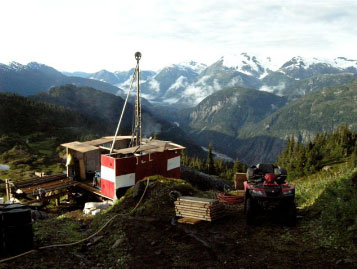VANCOUVER – Two revamped option agreements have enabled Ascot Resources (TSXV: AOT) to go from being a cash-strapped company unable to explore of its projects to a well-funded junior with three drills pulling promising intercepts from its gold property in northwest British Columbia.
Between 2007 and 2012 Ascot punched 382 holes into its adjacent Premier and Dilworth properties. The effort defined two deposits – Martha Ellen and Big Missouri – that collectively contained 89.4 million indicated tonnes grading 0.77 gram gold per tonne and 5.3 grams silver per tonne, plus 20.5 million inferred tonnes averaging 0.67 gram gold and 4.5 grams silver.
Then tough market conditions caught up with Ascot and the company found itself unable to raise money. In the first half of 2013 Ascot spent only $150,000 on its properties and yet by the end of June the company’s bank account was down to $573,900.
That put in serious doubt Ascot’s ability to fund its ongoing Premier-Dilworth property payments, which included roughly $1.5 million immediately and $27.7 million in late 2014. It is precisely the kind of challenge facing many junior companies today, but thankfully Ascot negotiated an answer.
In late July the company amended the option agreements for Dilworth and Premier, reducing its 2013 and 2014 obligations to less than $1 million annually. The bulk of the payments were deferred until late 2015, when Ascot will have to spend $9.55 million to complete its earn-in at Premier and $4.15 million to finalize its ownership at Dilworth.
In the mining world, much can change in two years. As such the new deals breathed new life into Ascot. A month later the company closed two private placements, raising $1.8 million in a flow-through financing priced at 75¢ per unit and $3.9 million in a regular financing priced at 70¢ per unit. In both, each unit comprised a share and a full-share warrant, exercisable at the financing price; the flow-through warrants expire in a year while the conventional warrants are good for two years.
Some of those warrants have already been exercised, putting another $1.2 million in Ascot’s coffers. All told, the financings have already raised $5.8 million.
That is the kind of money that can fund a drill program, and indeed within weeks Ascot had mobilized three drills to the Premier-Dilworth properties, which sit roughly 10 km north of Stewart in northwest BC.
The company is now most of the way through a 20,000-metre drill program and recently released results from the latest 26 holes. The holes tested the Martha Ellen deposit, which is on the Premier property, and the Sparky zone, which is on the Dilworth land package.
At Martha Ellen, the drilling effort is returning intercepts carrying grades as good or better than previous work. The longest intercept came in hole 470, which cut 71.5 metres grading 1.07 grams gold and 4.4 grams silver, starting 25 metres downhole. Hole 473 returned 44.5 metres grading 1.1 grams gold and 5.7 grams silver from 18 metres downhole, hole 485 cut 42 metres of 1.43 grams gold and 18.2 grams silver from 69 metres downhole, and hole 484 hit 34.8 metres of 1.8 grams gold and 4.4 grams silver from 35 metres downhole.
At Sparky, drills are testing to validate Ascot’s geologic model and so far the approach is working. Intercepts from Sparky include 32.6 metres grading 1.8 grams gold and 14.1 grams silver in hole 464 and 25 metres of 1.38 grams gold and 33.6 grams silver in hole 472.
Premier has been in production before – the Premier gold mine churned out 2 million oz. gold and 43 million oz. silver between 1989 and 1996. The mine is at the south end of the southern half of the property; the deposits Ascot has been delineating over the last few years are a few kilometres to the north. The Dilworth property is adjacent to Premier to the north and the same style of mineralization permeates both land packages.
That mineralization comprises gold and silver in quartz veins and quartz breccias, which also bear pyrite, sphalerite, and miner chalcopyrite. The stockworked veins and breccias sit within a sheet-lie zone that is faulted and displaced in places, a process that has left the prospective host rock near surface in some places and under cover in others.
Ascot still has three drills turning at Premier and Dilworth, so the company will be releasing more drill results in the coming weeks. The latest set of results was a boon to Ascot’s share price, which gained 14¢, or 16%, to reach $1.04. The jump extended a share price rally that started when Ascot resumed drilling and has lifted AOT shares from just 63¢ six weeks ago. Ascot has 91.6 million shares outstanding.


well done